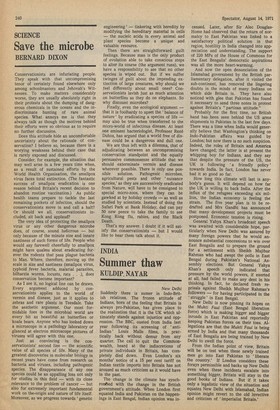SCIENCE
Save the microbe
BERNARD DIXON
Conservationists are infuriating people. They speak with that uncompromising tenor of certainty found elsewhere only among schoolmasters and Jehovah's Witnesses. To make matters considerably worse, they are usually absolutely right in their protests about the dumping of dangerous chemicals in the oceans and the indiscriminate hunting of rare animal species. What annoys me is that they always talk as though the motives behind their efforts were so obvious as to require no further discussion.
Does this attitude hide an uncomfortable uncertainty about the rationale of conservation? I believe so, because there is a worying weakness behind their case that is rarely exposed and discussed.
Consider, for example, the situation that may well arise in a few years time when, as a result of sustained efforts by the World Health Organisation, the smallpox virus faces total extinction. (The fantastic success of smallpox eradication is one reason behind Britain's recent decision to abandon routine vaccination.) As public health teams prepare to tackle the last remaining pockets of infection, should the conservationists move in and call a halt? Or should we all, conservationists included, sit back and applaud?
The very idea of protecting the smallpox virus or any other dangerous microbe does, of course, sound ludicrous — but only because of the minute size and innate nastiness of such forms of life. People who would say farewell cheerfully to smallpox might have qualms about eradicating forever the rodents that pass plague bacteria to Man. Where, therefore, moving up the scale in size and nastiness (smallpox virus, typhoid fever bacteria, malarial parasites, bilharzia worms, locusts, rats . . .), does conservation become important?
As I see it, no logical line can be drawn. Every argument adduced by conservationists applies to the world of vermin and disease, just as it applies to zebras and rare plants in Teesdale. Take the aesthetic argument. Our most formidable foes in the microbial world are every bit as beautiful as butterflies or koala bears. Anyone who has looked down a microscope in a pathology laboratory or glanced at electron microscope pictures of viruses will agree with this one.
Just as convincing is the conservationists' second line — the scientific value of all species of life. Many of the greatest discoveries in molecular biology in recent years have come from research on bacteria and viruses, including pathogenic species. The disappearance of any one species could be an appalling loss not only for studies in this field — with its close relevance to the problem of cancer — but also for extremely important fundamental work on the-origin and nature of life itself. Moreover, as we progress towards 'genetic engineering' — tinkering with heredity by modifying the hereditary material in cells — the nucleic acids in every animal and plant species become a unique and valuable resource.
Then there are straightforward guilt feelings. Because man is the only product of evolution able to take conscious steps to alter its course (the argument runs), we have a responsibility to see that no other species is wiped out. But if we suffer twinges of guilt about the impending extinction of large creatures, why should we feel differently about small ones? Conservationists lavish just as much attention on butterflies as they do on elephants. So why discount microbes?
Finally, even the ecological argument — that it is foolhardy to upset the 'balance of nature' by eradicating a species of life — may also be true when transferred to the micro-world of infectious disease. At least one eminent bacteriologist, Professer Rene Dubos, has argued that a world free of disease could be a dangerous and dull one.
We are thus left with a dilemma, that of adjudicating between an uncompromising conservation standpoint and the equally persuasive commonsense attitude that we should exterminate vermin and disease wherever possible. There is only one possible solution. Pathogenic microbes, agricultural pests and other nuisance species,' as they are successively eradicated from Nature, will have to be consigned to special micro-zoos, where they can be gawked at by holiday crowds — as well as studied by scientists. Instead of doing the Safari Park at Bank Holiday, dad can pay 50 new pence to take the family to see Kong Kong flu, rabies, and the Black Death.
That's my answer. I doubt if it will satisfy the conservationists — but I would like to hear them talk about it.


































 Previous page
Previous page